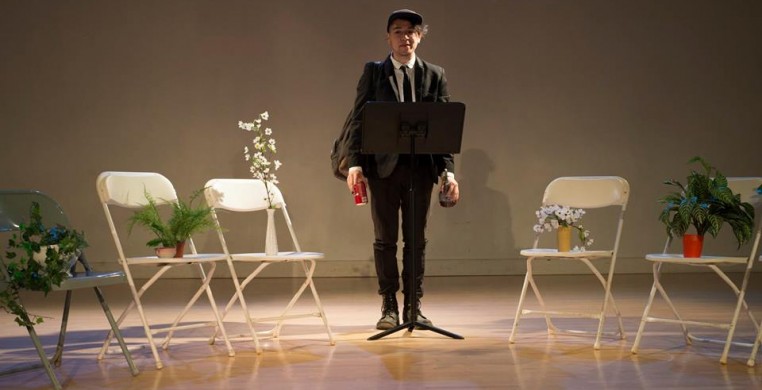Poonie’s Cabaret is a long running variety show created in memory of the life of Chicago dancer/choreographer Poonie Dodson, who died of AIDS in 1993. Over the years, Poonie’s Cabaret has taken many forms. Sometimes it incorporates dance, sometimes not. It often involves takes on difficult themes, wrapped in a fun light. Perhaps the only constant in Poonie’s is its unwavering mission to feature artists from the margins at Links Hall, often including (but not restricted to) LGBTQ artists. The series has been curated by some of Chicago’s best and most ridiculous art makers (in a good way), including Selene Carter, Jyl Fehrenkamp, Brian Hinkle and Matthew Hollis, Carole McCurdy and Joe Varisco. After a bit of an extended hiatus, Varisco revived Poonie’s Cabaret as the house for his new series “Post Q”. Post Q grew out of work and conversations he was having at Salonathon, Jane Beachy’s widely popular weekly performing arts foray known to highlight many of Chicago’s emerging and fringe artists.
This is a world that many SeeChicagoDance patrons have never experienced. Salonathon and Varisco’s subsequent Post Q are weird, wild, exciting, and feature people and art that are different from “downtown dance.” All that, and, they aren’t exactly dance shows. That doesn’t mean, however, that Post Q isn’t important to the dance community and its audience (that’s you), even if you’ve never left downtown.
Watching the five pieces on Friday’s program at Links Hall, it occurred to me that we create dances to communicate things that are impossible to say. I watched Poonie’s Cabaret/Post Q on the same night as the Bruce Jenner interview, five days after the death of Freddie Gray in Baltimore. Everything in the world seems to be on a grand tilt… like everything could change at a moment’s notice. Art is a way of processing, dealing with, or finding meaning in that “tilt.” In a way, it is quite liberating to mix and mince serious messages through dance, shrouding them in movement for which there can be multiple meanings.
But sometimes maybe we should just say what we mean.
Post Q and its companions in the experimental performance art community aren’t necessarily railing against mainstream artists (or, at least, it doesn’t seem that way). Post Q is about questioning assumptions surrounding art, being queer, and queer art. Out of this conversation come deeper questions related to the commodification and popularization of queerness, and to the politics of the body, the politics of race, the politics of class and gender – and, yes, even to the politics of Bruce Jenner.
Post Q is art. Performance art. Actually, it’s great performance art! But one must approach a performance like this knowing that it will be unfiltered, challenging, and you might not agree with everything. Communities of artists are not exactly democracies, but there’s room for everyone. That is never clearer than when attending Post Q.
Lucas Baisch & Julia Kriegel collaborated on the opening piece of spoken word with a title of “American Queer: Botanics and Bodily Fluids.” Baisch is the solo performer, surrounded by folding chairs and dressed like a character from “My So-Called Life.” He enters quickly and begins to take faux flora from his backpack, perching one plant on each of five chairs. He then cracks open a can of Coca-Cola before assuming his post behind a music stand nestled between the semi-circle of plants. Baisch talks quickly, asking way too many questions to possibly process their weight, and yet, collectively, his work hits you like a ton of bricks. Things I was able to get down on paper were: “Do you think it’s possible for plants to be gay? Are there gay plants? Kind of,” and “How can we be Post Q, post race, post class, post human, post anything? Unless you’re a plant.” Baisch draws this and many more fascinating parallels between us and plants, saying “Shift” before swiftly changing tangents, in the same way Bill T. Jones changed stories every minute according to the ding of a bell. Indeed, the closest thing I could compare “Botanicals and Bodily Fluids” to is a cross between Jones’ “Story/Time” and Zach Galifianakis’ “Between Two Ferns.” Because or in spite of this, I could have easily listened to him banter for twenty more minutes.
Even with four back-to-back spoken word pieces, Post Q is not wanting for diversity in its curation. Rolo Rodriguez, Anna Holmquist, and Mar Curran followed Baisch with deeply personal accounts, each with some funny parts, some serious parts, and plenty of “things that make you go hmm.” Rodriguez’s “Angel’s Hideaway” is as much about being Latino as it is about being queer. Mar Curran infuses a humorous manifesto, “How Queer are You,” (complete with a flip board visual aid) with poignant little windows into finding their identity amidst a Southside Irish Catholic family who somehow found itself watching “Queer Eye for the Straight Guy” together. Alexa Grae, as the only movement-based artist on the program, shocked us all by following their writhing tango-for-one with a spine tingling, angelic opera.
If the evening had a common theme, it was this: each artist on the program is living his/her/their own experience as a queer person, but more so as a human being. Definitions of queer are unique to each and every individual, and really, we’re ALL queer – every one of us – one way or another.

